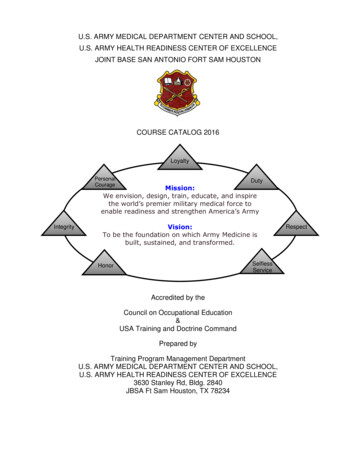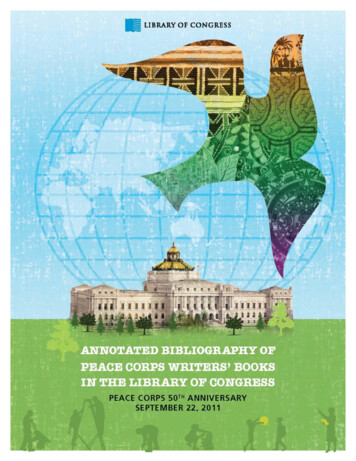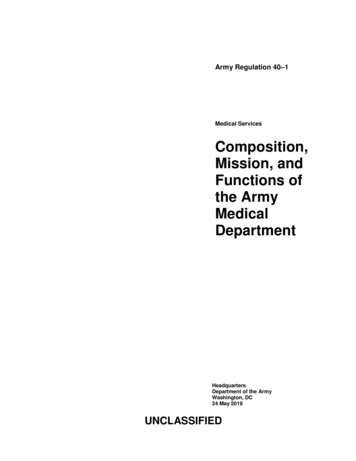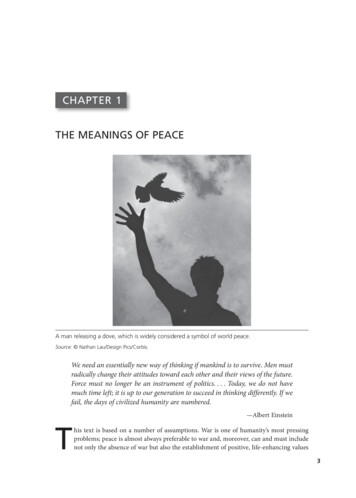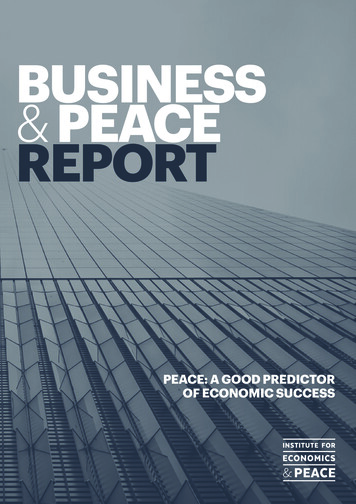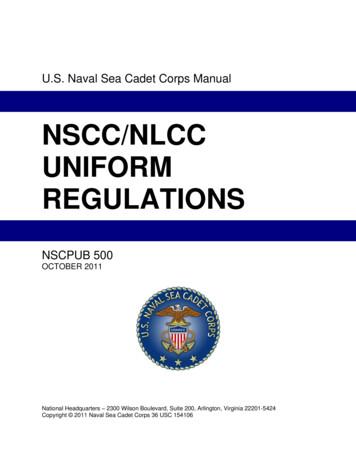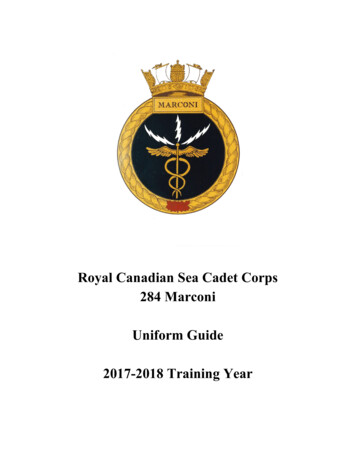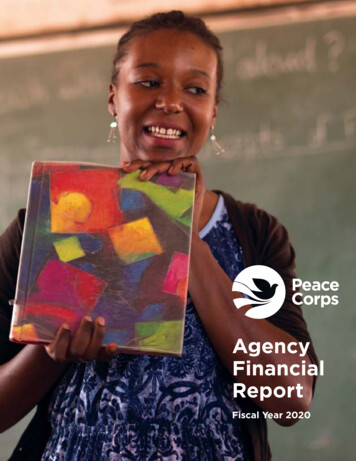
Transcription
AgencyFinancialReportFiscal Year 2020
The Peace CorpsAgency Financial ReportFISCAL YEAR 2020The Paul D. Coverdell Peace Corps Headquarters1275 First Street NE, Washington, DC 20526This report is available at rformance/Send comments or questions to peacecorps.gov/contact/ or to the mailing address above.
D The Peace Corps’ FY 2020 Agency Financial Report
IntroductionAbout This ReportHow This Report Is OrganizedThe Peace Corps Agency Financial Report (AFR)for fiscal year (FY) 2020 provides fiscal results andperformance highlights for the reporting periodbeginning October 1, 2019, and ending September30, 2020. This report demonstrates to the President,Congress, and the American public how fiscal funds,entrusted to the Peace Corps, have been utilized toachieve the agency’s mission of promoting world peaceand friendship through community-based developmentand cross-cultural understanding.The FY 2020 AFR presents the agency’s performancehighlights and accomplishments, fiscal accountability,and operational achievements and challenges for FY2020. It begins with a message from the Peace CorpsDirector, Jody K. Olsen, followed by three sectionsand appendices:The Peace Corps FY 2020 AFR is one of theperformance and financial reports required from federalagencies. It was prepared in accordance with Office ofManagement and Budget (OMB) Circulars A-11,Preparation, Submission, and Execution of the Budget;A-123, Management’s Responsibility for EnterpriseRisk Management (ERM) and Internal Control; andA-136, Financial Reporting Requirements. TheFY 2020 Annual Performance Report (APR), along withthe FY 2022 Annual Performance Plan (to be publishedwith the FY 2022 Congressional Budget Justificationin February 2021) and the FY 2020 AFR are madepublic and available online at peacecorps.gov.Management’s Discussion and AnalysisThis section showcases the Peace Corps’ mission,organizational structure, and the work of the Volunteers.It provides an overview of financial results, summary-levelperformance information, and management assuranceregarding internal controls.Financial SectionThis section details the agency’s financial positionfor FY 2020. It includes the message from the chieffinancial officer, followed by the audited financialstatements and footnote disclosures, and theindependent auditor’s report.Other InformationThis section contains the Office of Inspector General’sManagement and Performance Challenges and thesummary of financial statement audit andmanagement assurances.AppendicesThis section provides additional information, includinga report on audit follow-up activity, verification andvalidation of performance data, and a glossary ofabbreviations used throughout this report.Certifcate of Excellence inAccountability Reporting presented to thePeace Corpsin recognition of outstanding effort in preparing theAgency Financial Report for fscal year 2019Diane L. Dudley, CGFM, CPAChair, CEAR BoardAGA Certificate of ExcellenceThe Peace Corps was awarded the Association of Government Accountants’Certificate of Excellence in Accountability and Reporting (CEAR) for 13consecutive years. The CEAR is the highest form of recognition for Federalgovernment management reports, and the award demonstrates the agency’scommitment to transparent management reporting. The FY 2019 PeaceCorps Agency Financial Report can be viewed at peacecorps.gov.Ann M. Ebberts, MS, PMPChief Executive Offcer, AGAThe Peace Corps’ FY 2020 Agency Financial Report i
About The Peace Corps1The Peace Corps is a service opportunity for motivated change makers to immerse themselves in a communityabroad and work side-by-side with local leaders to tackle the most pressing challenges of our UMBER OF VOLUNTEERSAND TRAINEES IN FY 2020MARCH 1, 19616,893NUMBER OF COUNTRIES SERVEDIN FY 2020362 COUNTRIES58 POSTSGENDERAMERICANS WHOHAVE SERVED565% FEMALE35% MALEMORE THAN241,0002MARITAL STATUS99.6% SINGLE0.4% MARRIEDAVERAGE AGE : 27OVER AGE 50: 3%HOST COUNTRIESSERVED TO DATE1434PEACE CORPSRESPONSEPACIFIC ISLANDSNORTH AFRICA/MIDDLE EASTCARIBBEANCOUNTRIES YOUTH INDEVELOPMENT10%13%LATIN AMERICAHEALTH19%21%1PEACE CORPSDIRECTORJODY K.OLSEN(TUNISIA, EACECORPS.GOV4BUDGETFY 2020 BUDGET: 410.55MILLIONCARES ACT SUPPLEMENTAL FUNDING: 88MILLION6ii VOLUNTEERSBY SECTOR6The Peace Corps’ FY 2020 Agency Financial ReportAbout the Peace Corps reflects the number and breakdown ofVolunteers and Trainees evacuated from posts in FY 2020 due to theCOVID-19 pandemic.A person who served in two posts is counted in both posts. The numberis rounded to the nearest thousand.Volunteers are funded from appropriated funds and monies from thePresident’s Emergency Plan for AIDS Relief (PEPFAR). Of the 6,893Peace Corps Volunteers who were evacuated from posts in FY 2020 dueto the COVID-19 pandemic, 614 were funded by PEPFAR.Age as of the last day of the FY.“Posts” are the principal offices responsible for managing day-to-dayoperations within host countries. In some cases, multiple countries maybe administered from a single post to economize on overhead costs. Formore information on the Peace Corps’ countries of service, please refer tothe map in the next section.Number may not add to 100% due to rounding.
IntroductionWhere Peace Corps Volunteers Served In FY 2020Inter-America andPacific RegionCaribbeanDominican RepublicEastern Caribbean: Dominica Grenada and Carriacou St. Lucia St. Vincent andthe Grenadines JamaicaCentral andSouth AmericaBelizeColombiaCosta Africa ambiqueNamibiaRwandaSenegalSierra LeoneSouth AfricaTanzaniaThe GambiaTogoUgandaZambiaEurope, Mediterranean,and Asia RegionNorth Africa andthe Middle EastMoroccoEastern Europeand Central AsiaAlbania/Montenegro: Albania MontenegroArmeniaGeorgiaKosovoKyrgyz RepublicNorth acific IslandsFijiSamoaTongaVanuatuDue to COVID-19, the Peace Corps temporarilysuspended Volunteer operations at all Peace Corpsposts in March 2020. China Volunteers evacuated inFebruary 2020.The Peace Corps’ FY 2020 Agency Financial Report iii
Returned Volunteer, KatieO’Donoghue, taught Englishfor the Alternative LearningSystem Program once a week ina local barangay (village) in thePhilippines. Her class took place ina house with frequent visits fromcurious passers. This local boywould come by often to play, read,and mess with the other studentswhile they did their activitiesand assignments.iv The Peace Corps’ FY 2020 Agency Financial Report
IntroductionContentsA Message From the Directorof the Peace CorpsFinancial Section45 Message from the Chief Financial OfficerManagement’s Discussion and Analysis46 Financial Statements (Audited)6Mission and Overview of the Peace Corps50 Notes to the Financial Statements (Audited)7Our Organization70 Inspector General’s Audit Transmittal Letter8Work of the Volunteers72 Auditor’s Report20 Strategic Goals21Strategic and Management Objectives29 Performance Management System30 Forward-Looking InformationOther Information88 Inspector General’s Statement on the Peace Corps’Management and Performance Challenges106 Summary of Financial Statement Auditand Management Assurances32 Financial Summary and Highlights39 Analysis of Systems, Controls, andLegal ComplianceAppendices42 Management Assurances112 Verification and Validation of Performance Data110 Status of Audit Weaknesses114 Glossary of AcronymsThe Peace Corps’ FY 2020 Agency Financial Report 1
A Message From the Director of the Peace CorpsOn behalf of the agency, I present the FY 2020 PeaceCorps Agency Financial Report.This report provides our financial information and reflectsour accountability to goals and strategies that enable thePresident, Congress, and the public to assess the progressthe Peace Corps has made within the agency, country,and global community during this unprecedented yearin our history.This report conveys our commitment to sound financialand performance management and the effectiveness ofour grassroots efforts in local communities around theglobe. Our efforts this year include the March 2020 globalevacuation of Volunteers and Trainees, our robust plans fora return to service, agency management of the COVID-19pandemic, modernization of our IT systems, and the work ofour data governance council.The Peace Corps was established in 1961 by then-PresidentJohn F. Kennedy with a mission to promote world peaceand friendship. Since then, more than 241,000 Volunteershave served in 143 countries. These Volunteers haveperformed extraordinary work, including teaching Englishas a second language, working with HIV/AIDS preventionand care programs, and providing advice and instruction onnutrition and food availability issues. Fifty-nine years after itsestablishment, the mission of the Peace Corps remains asrelevant and innovative as ever—even while we as a nationand world face unparalleled challenges.The Peace Corps’ mission is to promote world peace andfriendship through three goals:1. to help the people of interested countries inmeeting their need for trained men and women;2. to help promote a better understanding ofAmericans on the part of the peoples served; and3. to help promote a better understanding ofother peoples on the part of Americans.The Peace Corps is a grassroots, people-to-people formof public service that works with host countries to developsustainable solutions. Peace Corps Volunteers are America’sbest ambassadors, and build relationships with strategicpartner countries from the ground up in communities acrossthe globe. Peace Corps Volunteer service is life-changingand returned Volunteers continue to share their experienceslong after they return to the United States.We will continue to build on our legacy to preserve thetreasure envisioned by President Kennedy and built byVolunteers and staff. As a dynamic agency, we are highlyresponsive to the evolving needs of host countries. Wehave learned to face new challenges, including a changingtechnology and communications landscape, ever-changingpolitical and safety and security environments aroundthe globe, and the COVID-19 pandemic, which led to thetemporary suspension of our overseas programs and the2 The Peace Corps’ FY 2020 Agency Financial Reportevacuation of our Volunteers and Trainees. Despite thesechallenges, our core values, mission, and goals have notchanged. We have not changed who we are, but we havechanged how we are who we are.Five goals have been identified as key steps theagency will need to undertake over the next year: (1)to resume overseas operations as soon as it is safe todo so, (2) to recruit and prepare applicants for service,(3) to communicate effectively across internal andexternal audiences, (4) to support and expand Third Goalopportunities for returned Volunteers, and (5) to maintainstrong continuity of operations (COOP) as we work withincurrent global limitations posed by the pandemic.Annual Updates, Highlights,and Areas of FocusCountry Re-entry Process: In the wake of the globalpandemic, the Peace Corps posts remain operational, andwe have maintained a staff presence in each country. Aswe prepare to welcome Volunteers back to service, we areundergoing country-by-country assessments that includeexamining safety and security, as well as health factorsacross our host countries. The Peace Corps has developeda comprehensive process for evaluating each post basedon medical, security, programmatic, administrative, andlogistical criteria that will allow the agency to determinewhen conditions are conducive to welcome Volunteersback to service. As we continue to learn more about howcountries are responding to the challenges posed byCOVID-19, it is clear that some posts are ready to receiveVolunteers well before others. Volunteer service will also bequite different from before, with limitations on Volunteertravel, greater caution when convening in groups, alternatework arrangements, and multiple measures to reduceinfection risk. For all posts, we are anticipating our Volunteercohorts will be small and sites will be within a reasonabledistance from their Peace Corps medical units.Viet Nam: In July 2020, we celebrated the signing of theimplementing agreement between the Peace Corps and theMinistry of Education and Training of Viet Nam to officiallyestablish the Peace Corps program in English education.Viet Nam will be the 144th country to host Peace CorpsVolunteers. The first class of Volunteers is scheduled to arrivein Viet Nam in mid-2022.“We will continue to build on our legacy topreserve the treasure envisioned by PresidentKennedy and built by Volunteers and staff.”– Jody K. Olsen, Director
Financial Stewardship: The Peace Corps remains dedicatedto prudent financial management, to maintaining financialdata integrity, and to ensuring reliability of financial reports.For the 14th consecutive year, we earned an unmodified(clean) audit opinion from our independent auditors onthe reasonableness of our FY 2020 Financial Statements;they identified two significant deficiencies and one instanceof noncompliance with laws and regulations. Our internalcontrols and financial management systems meet theFederal Managers’ Financial Integrity Act objectives asshown in the Management Assurances on page 42. ThePeace Corps remains committed to accountability andtransparency in all facets of our agency operations.Management and Performance Challenges: The agencycontinues to work with the Office of Inspector General (OIG)to address recommendations toward agency improvementsvia audits, evaluations, and management advisoryreports. In addition to standard reporting, the OIG alsoidentifies overall management challenges for the agencyto consider, including Volunteer health and safety, humancapital management, information technology, securitymanagement, compliance and planning, and implementationactions. In a concerted effort led by the Office of the ChiefCompliance Officer, overseas posts and domestic offices areprogressively working towards closing recommendations tomitigate future agency challenges as identified by the OIG.Kenya: We have made the decision to return to Kenya in FY2020. However, due to the global evacuation of Volunteers inFY 2020, we had to cancel the FY 2020 training group untilit is safe to resume Volunteer operations.Data Governance Council: The Peace Corps’ EnterpriseData Governance Council was formed this past year tohelp manage the agency’s enterprise data as a strategicasset as called for in the Foundations for EvidenceBased Policymaking Act of 2018. The intent of the DataGovernance Council is to foster a sustainable culture ofcontinuous learning and improved data management. TheCouncil is made up of senior staff officials who are appointedby the Peace Corps Director.Modernization of IT Systems: The agency took greatsteps to modernize our IT systems in the past year. Wemoved from an on-premises data center to a private cloudco-location, giving the agency streamlined maintenance,improved reliability, and enhanced security. Work isunderway to move multiple agency systems from separateplatforms to one shared platform. We have embarkedon a worldwide equipment refresh, upgrading muchneeded infrastructure at overseas posts. These milestonesposition the agency well to invest even more over the nextseveral years to further move to the cloud, develop newcollaboration tools for Volunteers and staff, and improveagency capability to make data-driven decisions.As we complete the third year of implementation of ourFY 2018-2022 Strategic Plan with appropriated fundingfrom Congress of 410.5 million for FY 2020, the agencycontinues to increase the efficiency and effectiveness ofoperations in support of the President’s ManagementAgenda. The financial and performance informationpresented in this report is reliable and complete.Throughout these difficult times, our dedication to ourcore mission has not wavered. The Peace Corps remains aleader in global development, world peace, and friendship.Countries around the world are preparing to receiveVolunteers again, and I pledge to them, and to you, that wewill return. We are poised to meet this moment.Jody K. OlsenDirectorNovember 10, 2020The Peace Corps’ FY 2020 Agency Financial Report 3
MANAGEMENT’SDISCUSSIONAND ANALYSIS6Mission and Overview of the Peace Corps7Our Organization8Work of the Volunteers20 Strategic Goals21Strategic and Management Objectives29Performance Management System30 Forward-Looking Information32Financial Summary and Highlights39Analysis of Systems, Controls,and Legal Compliance42 Management Assurances4 The Peace Corps’ FY 2020 Agency Financial Report
Management’sManagement’s Discussion and AnalysisReturned Volunteers Joshua Lycka and SheridanSalcedo are a married couple who served togetherin Paraguay. Joshua was an Agriculture Volunteerand Sheridan was an Education Volunteer. Althoughthey both worked in different sectors, they oftenfound ways to collaborate on projects. One projectwas a school garden that teaches students howto grow a variety of crops that they can thenincorporate into their diets.The Peace Corps’ FY 2020 Agency Financial Report 5
Mission and Overview of the Peace CorpsOUR MISSIONTo promote world peace and friendshipthrough community-based development andcross-cultural understanding.OUR VISIONTo be a dynamic, forward-leaning champion forinternational service, defined by our energy, innovation,and development impact.WHO WE AREInitially established by President John F. Kennedy byexecutive order on March 1, 1961, the Peace Corps wasformally authorized by Congress on September 22, 1961,with the passage of the Peace Corps Act. The PeaceCorps is an independent agency within the executivebranch of the U.S. Government.Since its inception, almost 60 years ago, the PeaceCorps has been guided by a mission of world peace andfriendship and continues to be a leader in internationaldevelopment and citizen diplomacy. In a profoundlyinterdependent world, we tackle challenges that knowno borders—such as access to education, food security,environmental concerns, youth development, andwomen’s economic empowerment.The agency exemplifies the best of the American spiritby sending Americans to serve communities aroundthe world, advancing development, and buildingcross-cultural understanding. Today, the Peace Corpscontinues to build strong relationships betweenour country and the people of our partner nations,while making a difference in overseas communities,in the lives of our Volunteers, and back home inthe United States.Periodically, the Peace Corps conducts a strategicassessment of its global presence and impact throughour Country Portfolio Review process. This reviewfacilitates effective responses to new requests forVolunteers while preserving and strengtheninglongstanding relationships with existing partners andhost countries. Moving forward, we have plans tore-establish Volunteer presence in all three regions assoon as local conditions permit for a Peace Corps thatwill be more vital than ever—collaborating with hostcountry partners, applying cutting-edge technologies,and pioneering best practices to deepen ourdevelopment impact.6 The Peace Corps’ FY 2020 Agency Financial ReportAs of the FY 2020 global evacuation of Volunteersand Trainees, the number of Volunteers and Traineesserving in the Peace Corps was 6,893. This included 614Volunteers funded by the President’s Emergency Planfor AIDS Relief (PEPFAR) and 152 Volunteers serving inshort-term, specialized assignments through the PeaceCorps Response Program. The number of Volunteersfielded each year is dependent on the availableappropriated funds and the priorities of the agency. Thisnumber was significantly impacted in FY 2020 due tothe global evacuation.“In our shrinking world, all peoples of theworld are neighbors. It is the responsibilityof all of us to understand our neighborsand to learn from one another.”– Sargent Shriver, Founding Director ofthe Peace Corps, 1961 to 1966
Management’s Discussion and AnalysisOur OrganizationPEACE CORPS ORGANIZATIONAL CHARTOffice of Victim AdvocacyDirectorJody K. OlsenOffice of Inspector GeneralOffice of Civil Rights and DiversityDeputy DirectorOffice of General CounselOffice of theChief FinancialOfficerOffice ofExternal AffairsSenior AdvisorsChief of StaffDeputy Chief of StaffOffice of VolunteerRecruitmentand SelectionOffice of HealthServicesOffice of GlobalOperationsOffice of Safetyand SecurityOffice ofManagementOffice of HumanResourcesOffice of theChief InformationOfficerOffice of the ChiefCompliance OfficerAfrica RegionOverseasPostsOffice of Overseas Programmingand Training SupportOffice of Sexual Assault RiskReduction & ResponseOffice of Strategic Information,Research & PlanningEurope, Mediterranean,and Asia RegionOverseasPostsPeace Corps ResponseOffice of Third Goal & ReturnedVolunteer ServicesOffice of InnovationInter-America andPacific RegionOverseasOffice of Global Health and HIVExecutive SecretariatPostsPrior to the COVID-19 pandemic and evacuation of allVolunteers and Trainees worldwide in FY 2020, thePeace Corps maintained active programs in 62 countriesadministered by 58 overseas posts. Each post is ledby a country director and supported by programming,training, safety and security, medical, financial, andadministrative staff. Overseas posts are organizedinto three geographic regions: Africa (AF); Europe,Mediterranean, and Asia (EMA); and Inter-America andthe Pacific (IAP).In addition to its Volunteers, the Peace Corps’ greatestasset is its workforce, comprised of 944 U.S. Direct-Hire(USDH) staff and 2,720 host country staff (includingshort-term language and cross-cultural training staff).The unique combination of USDH and host country staffcreates a flexible and vibrant workforce. The Peace Corpsrecognizes that having a diverse and inclusive agency isessential to advancing its mission.Though there are no Volunteers in the field as this reportis being prepared, domestic and overseas staff continueto work through the global complexities of the COVID-19pandemic to ensure the safe return of Volunteers toservice. The Peace Corps is actively engaged in acomprehensive process of evaluating each post basedon medical, security, programmatic, administrative, andlogistics criteria.Regional Office BreakdownChicagoOfficeOaklandOfficeNew York CityOfficeWashington, D.C.OfficeWest RegionCentral RegionEast RegionThe Peace Corps isheadquartered in Washington,D.C., with regional recruitmentoffices in Chicago, New YorkCity, and Oakland. There are70 recruiters across the nation,working to recruit and placequalified Americans from all walksof life to serve overseas as PeaceCorps Volunteers.The Peace Corps’ FY 2020 Agency Financial Report 7
Work of the VolunteersThe Path to Becoming a VolunteerWhat We DoEvery Peace Corps Volunteer is unique, and so is everyVolunteer’s service. What Volunteers have in common isa passion for service and an eagerness for life-definingexperiences. They are motivated change makers, readyto partner with communities to make a difference at thegrassroots level.Volunteers live and work abroad to help communitiesmeet the most urgent challenges of our time. Ratherthan provide monetary assistance to countries, thePeace Corps sends Volunteers to share their skills andexperience while they live and work in communitiesalongside local individuals.Most Peace Corps Volunteers serve for two years,following three months of training. The Peace Corpsprovides each Volunteer with a housing and living stipendthat enables them to live in a manner similar to people intheir community of service.This unique community-based approach todevelopment emphasizes intercultural understanding,capacity building, and sustainable results. Volunteersadvance citizen diplomacy, build local capacity, andbring a wealth of experience back to the United States.Volunteers develop language, intercultural, technical,and entrepreneurial skills that prepare them for jobsin a competitive global marketplace. They bring theseskills to their work in the public, private, and non-profitsectors, sharing their global experiences and outlookwith their colleagues, friends, and family. In turn, thishelps to build a more competitive U.S. workforce.Another pathway to Peace Corps service is Peace CorpsResponse, through which short-term, high-impactassignments are undertaken by returned Peace CorpsVolunteers and other experienced professionals.When applying to the Peace Corps, prospectiveVolunteers select the program that meets their interestsand aspirations. Candidates have an opportunityto indicate their preference for geographic region,programmatic sector, and date of availability. Allcandidates are encouraged to connect with one of 70Peace Corps recruiters in the United States, who candiscuss skill sets and expectations for service. The path tobecoming a Peace Corps Volunteer takes approximatelysix to nine months, starting from application submissionto departure for service.The Peace Corps’ Approach to DevelopmentCountries invite the PeaceCorps to partner with themin addressing theirdevelopment goals.Volunteers are requesteddirectly by local schools,government offices, andother community-basedorganizations.8 Volunteers live andwork at thegrassroots level.Volunteers learn locallanguages andcultures. They buildrelationships andtrust with people intheir hostcommunities.The Peace Corps’ FY 2020 Agency Financial ReportVolunteers use theirknowledge of localcontexts tocollaborate with hostcountry partners onprojects that addresscommunity needs.Volunteers workclosely with hostcountry counterpartsto strengthen thecapacity of localindividuals andcommunitiesto create solutionsfor developmentchallenges.Local conditions areimproved and thoseimprovements aresustained afterVolunteers leave.
Management’s Discussion and AnalysisReturn to ServiceThe Peace Corps continues to monitor and assess theCOVID-19 pandemic domestically and internationally.The locations and timing of returning Volunteers toservice will be determined on a country-by-countrybasis. While assessing the readiness to return tooperations for each of the countries we serve, werealize that some countries may be ready to receiveVolunteers well before other countries. Even within asingle country, there may be regions or programs thatopen earlier than others due to concerns related tohealth, safety and security, or due to pandemic-relatedprogrammatic disruptions.As the Peace Corps continues to navigate preparingprospective Volunteers to serve in the midst of a globalpandemic, evacuated Volunteers wishing to return toservice can undergo an expedited application process.Once the Peace Corps is able to successfully return toservice, Americans around the country will again havethe opportunity to immerse themselves in communitiesabroad and work side by side with local leaders to tacklethe most pressing challenges of our generation.“The people of this agency are like family to me. The same goes for ourVolunteers and the more than 240,000 returned Peace Corps Volunteers acrossthe United States. I will do everything I can to safeguard and celebrate thisextraordinary group of Americans.”– Director Jody K. Olsen, April 6, 2020Many Peace Corps Volunteerstake the opportunity to shareAmerican culture by celebratingHalloween wherever they serve.This is a local child posing withjack-o-lanterns in The Gambia. Aswe return to service, Volunteerscan once again, share Americawith the world.The Peace Corps’ FY 2020 Agency Financial Report 9
Work of the VolunteersENVIRONMENTThe Peace Corps’ Programmatic SectorsSince they are designed to respond to localneeds, Volunteer projects vary across the world.Globally, Volunteers’ work falls within six broadprogrammatic sectors: Agriculture, CommunityEconomic Development, Education, Environment,Health, and Youth in Development. For their part,Peace Corps Response Volunteers work on shortterm, high-impact service assignments acrossprogrammatic sectors.When applying for Volunteer service, Peace Corpscandidates can choose the programmatic sectorthat matches their skills, passions, and career goals—or opt to be placed where they are needed most.Peace Corps service can be the first step toward acareer or the continuation of one’s life work.476PEACE CORPSRESPONSE 7152EDUCATION2,826COMMUNITY ECONOMICDEVELOPMENT591YOUTH INDEVELOPMENT690VOLUNTEER ationTeaching lessons that last a lifetime.Nearly half of Peace Corps Volunteers work in theEducation sector—the agency’s largest. EducationVolunteers work on projects that focus on buildingteacher capacity, increasing student achievement,and helping communities to advocate and supporteducational initiatives. All Education Volunteers workin alignment with the national priorities of theirhost countries.The Teaching English as a Foreign Language (TEFL)project focuses on helping host country counterparts’professional development, including improving theirEnglish proficiency and teaching skills, which in turnleads to improved English language instruction andincreased English proficiency for students. In additionto formal classroom instruction, TEFL Volunteersparticipate in informal activities such as adult TEFLeducation and English clubs and camps. Volunteers canearn their TEFL certificate through the Peace Corps.Education Volunteers focusing on literacy and earlygrade reading promote improvement of students’ basicliteracy and numeracy skills and help teachers developstrategies for
The Peace Corps Agency Financial Report (AFR) for fiscal year (FY) 2020 provides fiscal results and performance highlights for the reporting period beginning October 1, 2019, and ending Septe
